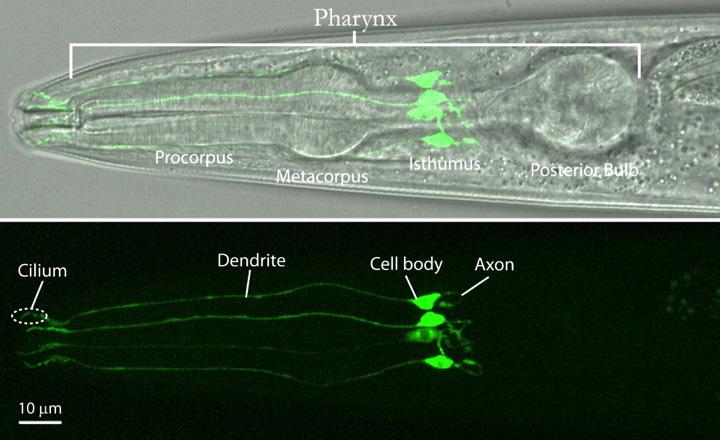Trained as a molecular and cellular biologist, I am interested in linking basic cellular mechanisms to broader evolutionary and developmentally relevant processes. For example, observations made largely within the past ten years have shown a direct connection between how unicellular organisms swim and how our kidneys function. I study the ‘hair like’ cellular appendages, called cilia or flagella, responsible for generating these motile- and sensory-specific functions (Figure 1). I am particularly interested in understanding how cilia/flagella function as sensory ‘antennae’ to facilitate cellular communication and to understand how ciliary gene regulation has evolved. Defects in these cellular structures are responsible for causing a wide range of human genetic disorders, and this work has broad implications for dissecting the molecular basis of these conditions.

Figure 1. The head of a transgenic C. elegans worm. (Top) A merged image showing a differential interference contrast (grey) and fluorescent image (green) of the pharyngeal region of a worm. (Bottom) Fluorescent image from the same worm shown alone. Fluorescence (green) represents a confocal projection of GFP-tagged protein, which localizes specifically to four CSNs in the head of a transgenic animal.
Students in my lab primarily work with the model worm Cenorhabditis elegans, which is a soil nematode that grows to only about one millimeter in length (Figure 1). There are approximately 1000 cells in adult animals and nearly one third of their cells (~300) are comprised of neurons. Interestingly, the only ciliated cells in C. elegans are found on a set of these neurons, called ciliated sensory neurons (CSNs). The cilium of a CSN protrudes from the tip of its respective dendritic process in a manner similar to the olfactory neurons of humans. Ciliated sensory neurons allow worms to forge for food, locate mates, and avoid unfavorable environmental conditions. However, the precise molecular mechanisms that mediated these processes are not fully understood.
Students who work in my lab use a combination of molecular and cellular techniques to determine how CSNs function in C. elegans. Much of this work involves constructing and imaging reporter gene fusion proteins, which are comprised of genes and/or gene promoters linked to green fluorescent protein (GFP). Imaging of these constructs is conducted using a laser scanning confocal microscope. These studies allow for us to determine the cells and/or subcellular localization of a specific protein that is involved in ciliary sensation.